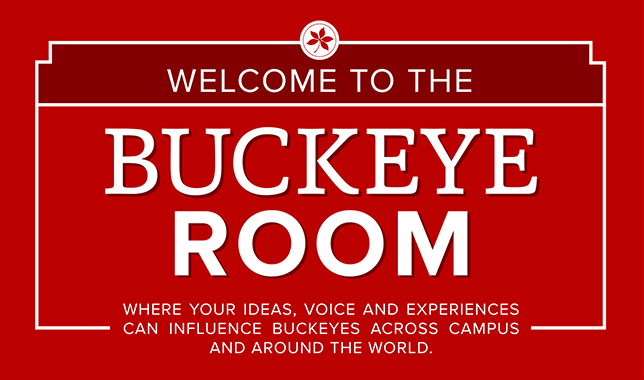Few institutions have as many alumni as The Ohio State University, with its 550,000 Buckeyes worldwide. But we all face similar challenges when it comes to keeping our alumni engaged at scale from afar.
Ohio State launched an online community called the Buckeye Room to solve those problems. They use the Buckeye Room to gather information on their alumni, solicit feedback, and keep them engaged.
We asked Molly Schmied, Director of Market Research & Insights in the Office of Advancement, to share more about the project and what other institutions can learn from it.
Could you explain to us what the Buckeye Room is, in brief? How did Ohio State conceive it?
The Ohio State University has over 550,000 living alumni around the world. These loyal graduates consider themselves Buckeyes for life. Yet for some, distance and busy lives prohibit them from being as intimately involved with the university as they would like. Understanding that keeping the connection alive is essential to furthering donor and alumni relations, the Office of Advancement turned to technology. We partnered with a firm called Vision Critical to establish the Buckeye Room, an exclusive online community designed to allow the university to solicit real-time feedback from alumni. The Buckeye Room engages alumni who want to provide input on issues and topics that are currently important to Ohio State. The ideas and experiences shared in the Buckeye Room help shape the university’s future.
People love to reminisce about their days in college. So, in addition to surveys and discussion boards that address Ohio State today, we make it a point to get people talking about the past. What were their favorite places to hang out? Did they meet their spouses while in college? What were their favorite Ohio State memories? These types of questions are peppered in with more operationally focused questions, creating a balance between fun and serious. The more engaging the discussions, the more frequently members participate in the research, and the more the university can learn from its alumni. I like to refer to the Buckeye Room as an insights community. It’s a community that is focused on collecting insights but has an engagement component as well. Engagement is purely meant for fun. The research, meanwhile, defines the insights that will drive the university forward.
How has the Buckeye Room been successful? What results has it generated for Ohio State?
We pay close attention to the information we gather from surveys and discussion boards and use what we learn to improve the overall alumni experience. Feedback generated through the Buckeye Room has led to a simpler way to order football tickets, a more user friendly web design, a cleaner layout for a departmental magazine, changes to the giving portal, and more. It even led to significant cost savings after we eliminated marketing materials that donors felt had little value.
In addition, certain members of the Buckeye Room were used to gauge interest in forming alumni societies for specific minority groups. The survey results indicated a high interest in these societies, and Buckeye Room members have since established the Asian/Asian-American Alumni Society and Hispanic-Hispanic-Latino Alumni Society.
On the engagement side, our community not only came up with the idea behind a marketing campaign, but also shaped it and saw a preview before it went live. Members said they wanted a look behind the scenes at Ohio State, so we teamed up with our marketing department to create a video series called With Buckeyes. This series featured Ohio State’s lesser-known departments and athletics programs, showing our students flying, dancing, running and racing. We shared these videos with our members before posting them on department websites and social media. Our open rates on these communication pieces were astounding. All of our share-back emails with members had an over 90 percent open rate.
Are there any particular problems you’ve had to solve or challenges you’ve had to overcome in launching the Buckeye Room? How did you do so?
During our first year, we focused on research and having an occasional fun touchpoint: newsletters, quizzes, e-cards, etc. They were well-received, but they weren’t enough. We needed a deliberate strategy with engagement like we had for research. So as we entered our second year, I added a member to the Buckeye Room team (of one) and charged him with creating a separate cross-functional advisory group to build an engagement strategy, co-create ideas for engagement activities and lend its talents to execute the strategy.
A few valuable lessons learned during the process were:
PARTNER with an outside vendor for the expertise and software needed to execute efficiently and with excellence.
START WITH A PLAN. Prior to launching the insights community, be sure to have at least a six-month roadmap of research and engagement activities and the cooperation of internal stakeholders you will need to execute these projects. Try to line up your engagement roadmap with your editorial calendar.
PROJECT MANAGEMENT IS CRITICAL TO SUCCESS. Running a program like this requires at least one full-time employee. And while you must gain diverse input, make sure that one person owns and drives the entire process.
INVOLVE others across the organization. Collaboration with all departments within your organization is essential to buy-in and creativity. Create advisory boards separately dedicated to research and engagement. Be strategic about who you include (creatives, event planners, marketing, communications), and make the meetings fun – go off-site if you can.
EXPERIMENT. Position your community as a test kitchen for new ideas, marketing content, events and programs.
EVANGELIZE. Always believe in the project and be ready to sell it within your organization. Proving ROI is often difficult with market research, so it is important to keep a record of the impact your insights community is making.


